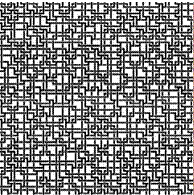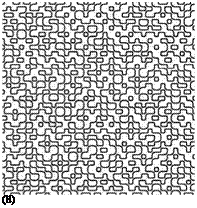Aside from using the tiles for the efficient production of plant positions, the nonperiodic tilings can be applied in many other places. One example is texture synthesis. For the photorealistic rendering of landscapes often a realistic ground texture has to be used. Here again we want small images that are to be repeated on the ground without repetition artifacts.
Nonperiodic tiling can be used for this purpose. A source image must be given that is then converted into a set of eight or more tiles that are repeated nonperiodically on the plane.
|
|
|

The method is based on an algorithm for texture synthesis proposed by Efros and Freeman [54] in which a large image is created by successively adding small square tiles that are obtained randomly from a source image. The tiles are assembled line by line. For combining a new tile with the already-existing image, an optimization process tries to generate a best fit between the tiles. This is done by defining an overlapping region in which a path is searched in a way such that the color differences of the two images along the path are minimal. Doing so, it is possible to generate from an appropriately chosen source image a large image that is quite similar in its characteristics.
Chapter 8 This algorithm is now adapted to the tiles. At random as many images are
Modeling Vegetation selected from the source image as colors are given by the tiles set (see Fig.
 |
 |
 |
8.13a-b). The images are selected as diamond-shaped regions – 45°-rotated squares.
These sources are now connected to form a tile with the corresponding colors by finding the optimal paths using the Efros and Freeman algorithm (see Fig. 8.13c). Here an error is determined that is minimized for a number of combinations of source images. if the system finds a combination with a small overall error, the user has to verify visually if the resulting tile set does not provide visible structures. More details can be found in [30]. Figure 8.14 shows two sample textures as well as two manually created patterns.



